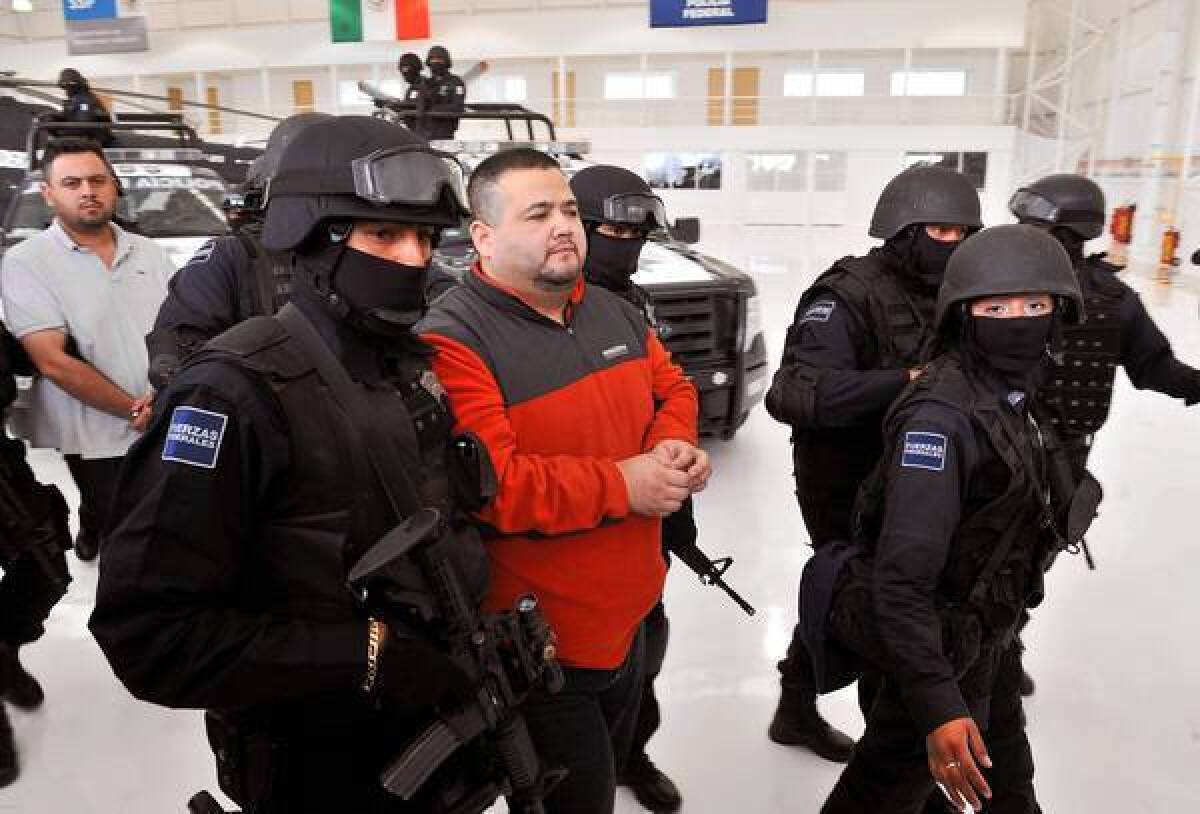Capture of Mexican mob boss began with a fed-up informant

- Share via
TIJUANA — The informant paid his own way to Mexico City and strode into a hotel room in an upscale neighborhood, willing to end the reign of one of Mexico’s most brutal crime bosses.
He wanted money, he told four Drug Enforcement Administration agents, but that wasn’t his primary motivation. The Tijuana drug cartel insider said he had grown disgusted by the savagery of Teodoro “El Teo” Garcia Simental — the pudgy kingpin whose criminal mayhem was generating headlines around the world.
Baja California, once a popular destination for day-tripping Americans, had become one of Mexico’s most violent regions. Army soldiers patrolled in convoys and manned bunkers flanking highways. Torture victims’ bodies hung from overpasses, and once-crowded beaches became playgrounds for mob bosses and their entourages.
Sitting across from the agents in a double-locked hotel room that day in late 2009, the informant handed over his cellphone. It listed a number he said was Garcia’s. An agent wrote it down.
“This is something I can do to clean up my country,” the informant said, according to an agent, who added: “He wanted to do his obligation as a citizen.”
That meeting, not previously disclosed, set off an investigation that quickly culminated with Garcia’s arrest during a predawn raid on his hideout in La Paz, in southeastern Baja. In a drug war plagued by setbacks and mistrust between U.S. and Mexican law enforcement, the capture was an example of binational cooperation that brought instant, lasting results.
The hunt for cartel chieftains yielded another major success Monday, when Mexican marines seized Miguel Angel Treviño Morales, the notorious commander of the Zeta organization. Like Garcia, he was known for extreme brutality.
When Garcia was captured three years ago, the beheadings, massacres, high-speed chases and daytime shootings stopped in Baja. Restaurant tables in Tijuana started filling up again, cops were no longer targeted, and some of the thousands of people who had relocated to San Diego started moving back into the city.
In the years immediately before the raid, such a scenario was hard to imagine.
Garcia was a “Batman”-esque villain whose lieutenants included a man sporting skull tattoos for every murder he committed and a former bricklayer whose sole job was to dissolve enemies in barrels of lye.
The Tijuana organized crime group that spawned Garcia, better known as the Arellano Felix drug cartel, had long operated in Tijuana, largely tolerated under an unwritten code: Criminals were free to move their drugs to the U.S. as long as they kept their bloodletting among rivals.
Garcia broke all the rules.
A onetime enforcer, he assembled his own crew and started targeting the citizenry, kidnapping hundreds and holding them for ransom. Garcia extorted shoeshine vendors and human smugglers alike and roamed his east Tijuana stronghold in a convoy of 10 vehicles.
In April 2008, Garcia’s clash with a cartel rival left 14 dead on a highway, triggering a drug war that introduced a style of terror that would become commonplace across Mexico. Garcia’s rivals weren’t just killed; they were mutilated and had their tongues cut out. They were rolled in carpet and set aflame. Many were beheaded and tossed onto busy streets.
U.S. authorities in San Diego watched the carnage with growing concern. They had demolished the cartel’s upper ranks through arrests and prosecutions, only to watch the once-obscure Garcia ascend. In a 2008 intelligence report, the FBI expressed concern that drug war violence would spill over the border, noting that senior members of Garcia’s gang lived in downtown San Diego.
Some federal agents and prosecutors wanted to indict Garcia and have him extradited to the U.S.; others said the situation was too urgent to wait for a case to be put together.
“We always wanted to press charges on Teo, but when you’re listening to death and destruction every day and the kidnapping of people, you just can’t allow it” to go on, said one high-ranking U.S. law enforcement official who, like others, spoke on the condition of anonymity because of security concerns.
Garcia expertly eluded capture. He constantly switched phones and rarely called twice from the same location. Police informants alerted him at the first sign of trouble, most memorably in 2009, when Garcia and his cronies escaped a raid at his rented oceanfront cottage by running down the beach.
U.S. authorities did have a tenacious ally: Tijuana’s then-secretary of public safety, Julian Leyzaola. His 2,000-officer police force had once functioned as little more than an arm of organized crime, but Leyzaola had purged hundreds.
The remaining cops were caught between the professional demands of Leyzaola and the death threats and bribes of the shadowy crime boss. Forty-five officers eventually died at the hands of Garcia’s gunmen.
Leyzaola came close to capturing Garcia in August 2008. After seeing Garcia’s convoy of Tahoes and Suburbans filling up at a gas station, his team gave chase at speeds up to 150 mph. Leyzaola’s heavily armored vehicle bottomed out in the dirt in a hilly area, and Garcia got away. But the constant pressure forced Garcia to move out of the city, still in charge but vulnerable.
The informant decided to act.
Though the DEA has an office at the U.S. Consulate in Tijuana, the informant chose to make contact with U.S. authorites far away from Baja California. He called the DEA at its regional headquarters at the U.S. Embassy in Mexico City.
The DEA was accustomed to receiving blustering types who exaggerated their claims in search of a quick payday. This source wasn’t like that. He had paid for his flight to Mexico City, for one thing. And his working knowledge of the organization matched the DEA’s information.
He also had no criminal record, was well-dressed and sported a professional attitude. “He was a cool, collected person,” said one agent who was in the hotel room. “That’s what triggered our interest. This source wasn’t fishing for how much he was going to get paid.”
Agents analyzed call records and determined that the telephone number he gave them was indeed Garcia’s. Within weeks, they had tracked Garcia to an upscale development near Cabo San Lucas.
The agents contacted a Mexico City-based federal police commander whose highly trained unit had partnered with the agency on other kingpin arrests. “When you have a good lead, you need to act fast,” said Gary Hill, assistant special agent in charge at the DEA’s San Diego office.
The target information remained secret. No local police in La Paz were notified, and only three members of the squad were told whom they were pursuing.
Early on Jan. 12, 2010, 100 federal police flew into La Paz and boarded two tour buses. When the drivers saw the masked lawmen filling the aisles, they refused to drive until they were given a bonus.
The buses parked on either end of Garcia’s street. As a Blackhawk helicopter circled overhead, the team rammed open the palm-flanked front door and swarmed in. Balloons from Garcia’s daughter’s birthday party the day before floated in the living room. Rousted from bed, Garcia scrambled onto a balcony and was caught trying to get on the roof.
No weapons were found. Garcia had been caught by surprise, in his “tighty whities,” as one U.S. agent described it.
“There were 100 guys preparing for the worst and, turns out, it was just a guy in his underwear,” one agent said.
Even with Garcia’s arrest, organized crime in Baja California is far from eliminated. Authorities believe that the Sinaloa drug cartel has taken over and that given the region’s proximity to U.S. drug markets, it will remain a heavily contested trafficking corridor.
But a semblance of order has been restored.
These days, Baja California is better known for its funky nightlife in downtown Tijuana, the beloved Mexican soccer league champion, Xolos de Tijuana, and the seafood-infused Baja-Med cuisine that draws celebrity chefs and foodies from around the world.
“Instead of being dominated by fear, now civic life revolves around hope, and that leads to much better things in the future,” then-President Felipe Calderon said in a 2010 interview with The Times.
Three years later, Garcia remains locked up in a high-security prison outside Mexico City.
And the informant from Baja California who made it all happen? Said one agent: “He’s still alive, living happily, in that general area.”
More to Read
Sign up for Essential California
The most important California stories and recommendations in your inbox every morning.
You may occasionally receive promotional content from the Los Angeles Times.














